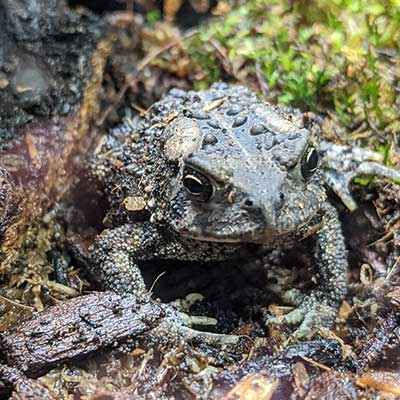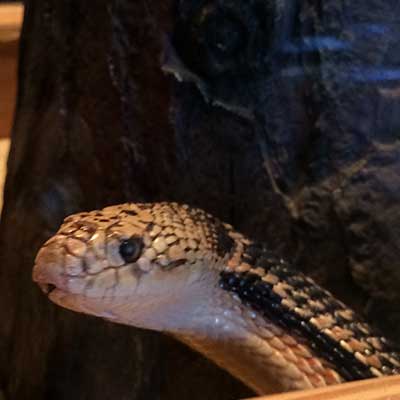Here at Baltimore Woods Nature Center we take care of several different animals. Most of them were donated to us when they either could not be released back into the wild due to environmental regulations or could no longer be cared for by their original owners. We give them the care they need and use them to help teach our community about animals native to Central New York. We have a special permit to keep these animals for educational purposes and are not a rehabilitation center.

American Toad
Have you met our American toad (Bufo americanus) yet? This toad is about four months old and growing fast! We acquired it to help us teach about amphibians. A female American toad can lay up to 500 eggs every spring which means that there are a lot of toads hopping around in summer but many of them will not survive their first winter. We were given special permission from the DEC to keep the toad, and all of our animals, as a way to teach people. All native species of reptiles and amphibians are protected in New York State and you should never keep one as a pet without a license. We feed the toad crickets and sometimes mealworms. In the wild, American toads will eat many things including different types of insects, earthworms, slugs, and snails. Look at how fast it catches this cricket!

Fern the Wood Turtle
Meet Fern, our wood turtle (Glyptemys insculpta). Fern came to us when her previous owners could no longer take care of her. We believe that she is around 40 years old! Wood turtles are found across much of the Northeastern United States, including parts of Canada. They are typically found near moving water and prefer streams or rivers with sand or gravel bottoms. Here at The Woods, Fern eats a mixture of greens, mealworms, crickets, berries, and turtle food to make sure she gets all the nutrients she needs. In the wild, wood turtles will eat most anything they come across, but typically stick to leaves, fruits, and flowers.They’ll also hunt for slugs, worms, and insects. If you are lucky you may get to see one of Fern’s graceful dives into her tank.

Miss Hiss, Northern Pine Snake
Say hi to Miss Hiss, our northern pine snake (Pituophis melanoleucus melanoleucus). Miss Hiss is over seven feet long and came to us 20 years ago when her owner could no longer take care of her. We believe that she is over 25 years old. Northern pine snakes are burrowing snakes that are found in New Jersey and the Western Appalachian mountains. They prefer to live in pine forests with sandy soils that they can dig in. We feed her whole rats. In the wild, northern pine snakes eat rodents, other small mammals, birds, and bird eggs. Miss Hiss used to help us teach Nature in the City lessons too, until she got too big. Now she helps greet visitors that come to visit the discovery library at The Woods.

Eastern Box Turtles
Lucy, Mr. T, and Geronimo are all Eastern box turtles (Terrapene carolina carolina) that live at The Woods. You may not see these guys often because they are our star educators. They help us teach kindergarteners with our Nature in the City program. All three of them came to us in 2010 after the DEC rescued them from the illegal pet trade. They have been teaching with us ever since. Eastern box turtles are found all across central and south-eastern North America and are often seen in vegetated areas near streams or ponds. Our box turtles eat a mixture of greens, slugs, crickets, berries, small mice, and turtle food to make sure they get all the nutrients they need. In the wild they like to eat many things including plants, mushrooms, fruits, insects, fish, small amphibians, and eggs.

